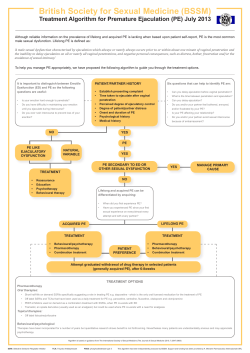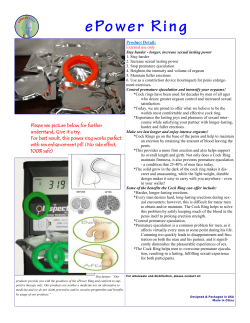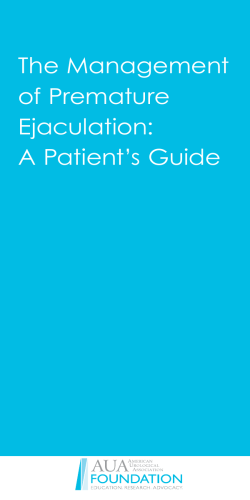
Document 146609
SA MEDICAL JOURNAL VOLUME 66 8 DECEMBER 1984 889 Pregnancy following treatment of retrograde ejaculation with clomipramine hydrochloride A report of 3 cases S. M. EPPEL, M. BERZIN Summary In 2 out of 3 cases of retrograde ejaculation treatment with clomipramine hydrochloride resulted in' normal ejaculation and conception. The 3rd patient was only partially helped by the drug. The mechanisms of ejaculation, the causes of retrograde ejaculation, the management of the condition and the relevant pharmacological features of the tricyclic antidepressants are discussed. S Atr Med J 1984; 66: 889-891. Retrograde ejaculation (RE) is a relatively uncommon cause of infertility in the male. Several methods have been used in its management, most of which involve either a major surgical procedure or techniques both uncomfortable and embarrassing for the patient. The tricyclic drug imipramine has been used successfully in this condition I and we report the use of one of its derivatives, clomipramine. Case reports Case 1 A 31-year-old man had been an insulin-dependent diabetic since the age of 10 years. He had married at 22, had normal sexual function and fathered a child at the age of 24. Two years later, in 1978, the volume of his ejaculate gradually decreased, although he remained sexually active. As the result of severe diabetic nephropathy he progressed into irreversible renal failure and had a renal transplant in 1979. He also divorced his first wife in 1979 and remarried that same year. Because of the desire to have children in this second marriage, he was referred to the Infertility Clinic at Johannesburg Hospital. On examination he was found to be in reasonably good health, with no sign of any infection, active disease or rejection of the transplanted kidney. He was on multiple drug therapy including 80 units of monocomponent insulin per day, prednisone 25 mg/d, azathioprine 125 mgld, acebutolol 100 mg twice a day, prazosin 0,5 mg/d and hydrallazine 150 mgld. His diabetes was well controlled and his blood biochemical values were normal. Hormone levels were as follows: testo- Division of Urology and Endocrine Unit, Department of Medicine, Johannesburg Hospital S. M. EPPEL, M.B. B.CH., F.R.C.S. M. BERZIN, M.D. (RIGA) sterone 25,3 nmol/l, luteinizing hormone (LH) 5 mIU/ml and follicle-stimulating hormone (FSH) 2 mIU/ml, all within the normal range. Examination of his urine after masturbation confirmed the presence of spermatozoa. He was started on treatment with clomipramine hydrochloride 25 mg twice a day and after 5 days of treatment developed normal ejaculation. The normal panern of ejaculation was maintained for up to 10 days after stopping the drug. It was therefore suggested that he take the tablets for 5 days before his wife's calculated mid-cycle. Four months later his wife was pregnant. Case 2 A 27-year-old man had undergone an internal sphincterotomy (bladder neck incision) in 1980. The indication for this was not clear, but he had apparently had symptoms of prostatism for years and had experienced an episode of acute urinary retention. He had noticed no ejaculate since this procedure and by the time he came to the Infertility Clinic he had been taking ephedrine periodically for about 1 year to no avail. He appeared healthy with normal routine blood biochemical values, and the hormonal profile was as follows: testosterone 28,6 nmol/l, FSH 5 mIU/ml, LH 7 mIU/ml and prolactin 4 ng/ml, all within normal limits. Post-masturbation urine contained spermatozoa. He was started on clomipramine hydrocWoride 25 mg twice a day and within 5 days ejaculated normally. He refused to return for semen analysis, but 5 months later his wife was pregnant. Case 3 A 29-year-old man had been involved in a motor vehicle accident in June 1971 and had sustained fracture· of the pelvis and a low extraperitoneal bladder rupture; this had been tr.eated conservatively and he had made a reasonable recovery. SIX months after the injury when he recommenced sexual activity he noticed the absence of ejaculation. He did not seek advice until his marriage in 1977, when he wished to have children. The patient appeared healthy. The routine blood biochemical values were normal and hormone levels were as follows: testosterone 22,3 nmol/l, LH 5,3 mIU/ml and FSH 4 mIU/ml, all within the normal range. Examination of a centrifuged specimen of urine voided immediately after masturbation demonstrated the presence of spermatozoa. The patient was started on clomipramine hydrocWoride 25 mg twice a day, and after 3 days he ejaculated normally, bur only with a full bladder. He stopped treatment after a week because of arrxiety. He continued to achieve normal ejaculation using the 'full bladder' technique and a spermogram of a masturbated specimen after 7 days of abstinence revealed a volume of 8 ml, normal viscosity, a sperm count of 20 million 890 SA MEDIESE TYDSKRIF DEEL 66 8 DESEMBER 1984 per millilitre, 50% motility, 12% normal forms and 88% abnormal forms, and a fructose level of 2,6 mmol/l. This couple's infertility problem was compounded by the fact that the wife had recently been operated on for a fibroid uterus. Discussion Mechanisms of ejaculation The ejaculatory process consists of two distinct entities, emission and ejaculation. 2 Emission is the deposition of seminal fluid components from the vasa deferentia, seminal vesicles and prostate into the posterior urethra, whereas ejaculation is the trajection of seminal fluid through the urethra and its expulsion. Neural control is by the sympathetic nervous system acting largely through a-adrenergic receptors. The seminal vesicles and vasa deferentia contain smooth-muscle and elastic fibres, and under the influence of sympathetic stimulation they discharge their contents into the posterior urethra. Closure of the bladder neck (internal sphincter) is a vital part of emission as it prevents the backflow of seminal fluid and therefore 'holds' the fluid in the posterior urethra in preparation for ejaculation. The bladder neck remains closed during expulsion of seminal fluid from the urethra. The smooth-muscle cells of the bladder neck have a rich supply of a-adrenergic receptors, and this region therefore lends itself to pharmacological manipulation, particularly with a-adrenergic stimulation and blockade. The sympathetic nerve supply to the organs concerned with emission and ejaculation originates in the thoracic and upper lumbar segments of the spinal cord. After leaving the cord these fibres run in the paravertebral sympathetic chain; some synapse with the sympathetic ganglia, while others synapse with peripheral ganglia. The abdominal and pelvic plexuses all receive sympathetic fibres. The hypogastric nerves originate in the superior hypogastric ganglion (presacral nerve) which extends from L4 to SI, and stimulation of these nerves has been shown to produce contraction of the bladder neck, prostatic musculature, seminal vesicles and ejaculatory ducts. 3 We know that the motor sympathetic fibres concerned with ejaculation reach the presacral and hypogastric nerves from the first lumbar ganglion because lumbar sympathectomy will not interfere with ejaculation provided that this ganglion is preserved, although some authors have reported that preservation of the second and third ganglion may be important in preventing RE. RE, a reduced volume of ejaculate, reduced orgasm and other sexual dysfunctions. Spinal cord injuries may cause problems of erection, ejaculation and orgasm, but RE in isolation is uncommon. Impotence due to the inability to obtain or maintain an erection is well described with a fractured pelvis. However, there appear to be no reports in the literature of RE as the only sexual abnormality associated with a fractured pelvis, as described in case 3. This patient had sustained a ruptured bladder and it is conceivable that the vesical neck was injured. There is one doubtful report of RE due to a urethral stricture. 5 Neurological disease can cause RE, seen classically in patients with diabetic autonomic neuropathy; it may occur in isolation as described in case I, or with other forms of sexua( dysfunction such as ejaculation without erection. These problems are usually not reversed by control of the diabetes. Spinal cord diseases, such as amyotrophic lateral sclerosis, syringomyelia, or multiple sclerosis may affect erection or ejaculation or both. Antihypertensive drugs, particularly the a-adrenergic blocking agents, may decrease emission and cause RE. These include phenoxybenzamine, bethanidine and prazosin. Peripheral sympatholytic agents such as guanethidine and ganglion blockers such as hexamethonium may have similar effects. Antipsychotic drugs such as chlorpromazine and haloperidol may also cause RE, and, paradoxically, one of the tricyclic antidepressants, amitriptyline, has been shown to produce the condition. Treatment RE has been managed by different methods. There have been several reports of successful artificial insemination after collection of the retrograde ejaculate with a catheter. 6 ,7 However, this method is associated with problems such as contamination of the sperm with urine and the necessity for obtaining the correct pH. Surgical reconstruction of the bladder neck has been described. 8 Other techniques are available, such as coitus with a full bladder, the method used in case 3, and even urination directly into the wife's vagina immediately after intercourse. Following Stockamp et al.'s article9 on the use of a-adrenergic drugs in this condition, several encouraging reports have appeared in the literature. The Tel Hashomer team in Israeli were the first to demonstrate the effective clinical use of the tricyclic antidepressants to reverse RE. They used imipramine, a compound closely related to clomipramine. Causes of RE 2,4 Mechanism of action of the tricyclic antidepressants Certain congenital malformations of the posterior urethra may in rare cases cause RE. A number of surgical procedures also result in various forms of sexual dysfunction, including RE. All forms of prostatectomy for benign disease have an incidence of associated RE varying from 50% in some series to 100% in others. There is a greater tendency for RE to occur after transurethral prostatectomy than after open procedures. Incision of the bladder neck, as illustrated in case 2, may result in RE. Abdominal and pelvic operations which interfere with the sympathetic nerve supply will invariably result in RE. In lumbar sympathectomy RE and other disorders of sexual function may be prevented if certain of the lumbar ganglia are preserved. RE has been associated with retroperitoneallymphadenectomy for testicular tumours and with abdominal and pelvic vascular surgery where operative injury to the hypogastric nerves and pre-aortic plexus is likely to cause RE or a dry emission. Likewise, abdominoperineal resection for carcinoma of the rectum will usually result in impaired erection, It is well known that the bladder neck is richly supplied with a-adrenergic receptors. Pharmacological manipulation of the bladder outlet is commonly undertaken by the use of recognized a-adrenergic blocking agents such as phenoxybenzamine and a-adrenergic stimulants such as ephedrine. Clomipramine and other tricyclic antidepressants are thought to have an a-adrenergic stimulating action. Khanna et al. 10 demonstrated that imipramine increased bladder outlet pressure by acting on the a-receptors. Baldessarini, II however, makes no mention of the a-adrenergic stimulating effects of the tricyclic antidepressants. In fact, this text refers to the aadrenergic blocking action of these drugs. It is mentioned, however, that they potentiate the action of biogenic amines, particularly noradrenaline and 5-hydroxytryptamine, by blocking their neuronal re-uptake at nerve terminals. Clomipramine apparently has a rather selective action in blocking 5-hydroxytryptamine transport, suggesting that this amine may be an important neurotransmitter in the region of the bladder neck. SA MEDICAL JOURNAL Conclusion Our experience endorses the fmdings of other authors that the tricyclic antidepressants may successfully be used to treat RE caused by damage to the bladder neck and diabetic neuropathy. The treatment has resulted in pregnancy in 2 of our 3 cases. We thank Professor P. this article. J. P. van Blerk for his help in preparing REFERENCES 1. Brooks ME, Berzin M, Braf Z. Treatment of retrograde ejaculation with imipramine. Urology 1980; 15: 353-355. 2. Lipschultz LI, McConnell J, Benson, GS. Current concepts of the mechanisms of ejaculation: normal and abnormal states. ] Reprod Med 1981; 26: 499-507. VOLUME 66 8 DECEMBER 1984 891 3. Learmonth JR. A contribution to the neurophysiology of the urinary bladder in man. Brain 1931; 54: 147. . 4. Newman HF, Reiss H, Northup JD. Physical basis of emission, ejaculation and orgasm in the male. Urology 1982; 19: 341-350. 5. Virupannavar C, Tomera F. An unusual case of retrograde ejaculation and a brief review of management. Fereil Seeri11982; 37: 275-276. 6. Glezerrnan M, Lunenfeld B, Potashnik G, Delsner G, Beer R. Retrograde ejaculation: pathophysiologic aspects and eeport of rwo successfully treated cases. Fmil Seeril 1976; 27: 796-800. 7. Lissoos I, Hurwitz MB, Dunn DS. Retrograde ejaculation and pregnancy: a case report. S Afr Med] 1981; 59: 874. 8. Abrama JI, Solish GI, Booejian PL, Waterhouse RK. Surgical correction of retrograde ejaculation.] Urol 1975; 114: 888-890. 9. Stockamp K, Schreiter F, Alrwem JE. Alpha-adrenergic drugs in retrograde ejaculation. Fmil Seeri11974; 25: 817-820. 10. Khanna OP, Elkouss GC, Heber DL, Gonick P. Imipramine hydrochloride pharmacodynamic effect on lower urinary tract of female dogs. Urology 1975; 6: 48-53. 11. Baldessarini RJ. Drugs and the treatment of psychiatric disotders. In: Goodman Gilman A, Goodman LS, Gilman A, eds. The Pharmacological Basis of Therapeueics. New York: Macmillan, 1980: 418-427. Staphylococcus aureus tricuspid valve endocarditis in young women after gynaecological events A report of 3 cases P. J. SWIFT Summary Three cases of Staphylococcus aureus tricuspid valve endocarditis are reported; each was preceded by a gynaecological event In 2 cases there was no overt pelvic sepsis and there had been no operative or instrumental intervention, but in the 3rd pelvic inflammatory disease was present, probably not as a result of interference. There are few reports in the recent literature of gynaecological events precipitating this condition; in contrast, intravenous narcotic abuse is well documented. In the literature there is insufficient stress laid on the fact that non-septic gynaecological events may cause the endocarditis. The difficulties in diagnosing tricuspid endocarditis, especially in a milieu where intravenous narcotic abuse is virtually unknown, are noted. When endocarditis is present in women known not to abuse narc'otics, the absence of signs of pelvic inflammation may also cause difficulties in diagnosis. S Air Med J 1984; 66: 891-893. Isolated tricuspid valve endocarditis caused by Staphylococcus aureus is usually associated with intravenous narcotic abuse. l A major textbook of cardiology states that right-sided bacterial endocarditis should be suspected in persistent fever in narcotic Department of Medicine, Cecilia Makiwane Hospital, Mdantsane, Ciskei P. J. SWIFr, F.C.P. (SA) addicts, in infants with septic skin lesions and in patients after cardiac surgery.2 There are a few reports of the association of tricuspid valve endocarditis with ~naecological or obstetric events in the European literature,3- but only 2 reports could be found in the English-language literature. 8•9 Apparently little stress is placed on the fact that there may be no pelvic sepsis and no history of operative or instrumental intervention. Tricuspid valve endocarditis has also been reported in a young female without a primary site of infection. IQ . Case reports Case 1 In 1978 an 18-year-old Black woman presented with a 2month history of cough, persistent sputum, dyspnoea and malaise. There were temporary responses to four separate antibiotic courses. Mter her condition deteriorated she was referred to the thoracic surgery department of the Cecilia Makiwane Hospital with a diagnosis of multiple lung abscesses. There was no history of cardiac disease. On examinatio.n the patient was ill, toxic and pyrexial. There were no splinter haemorrhages or clubbing. The jugular venous pressure (IVP) was normal. No cardiomegaly was noted. A short grade 1/6 systolic murmur was audible at the lower left sternal edge. Findings on gynaecological assessment were normal. Investigations revealed normochromic, normocytic anaemia, a neutrophil leucocytosis and a markedly elevated erythrocyte sedimentation rate (ESR); three blood cultures grew Scaph. aureus. Chest radiographs showed evanescent migratory pulmonary infiltrates, which tended to cavitate (Fig. 1). Therapy with intravenous cloxacillin was started because staphylococcal tricuspid endocarditis with septic pulmonary emboli was suspected. Seven days later the patient developed marked facial oedema, accompanied by a large c-v wave in the
© Copyright 2025
















